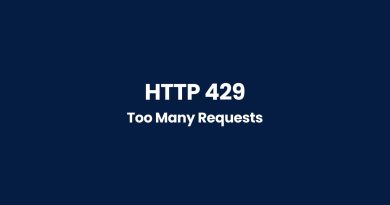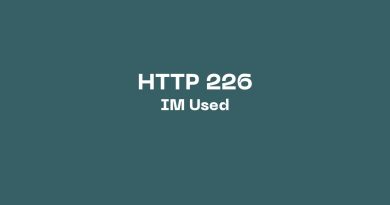HTTP 412 (Precondition Failed): What Is It and How to Fix It
When you’re troubleshooting an issue related to web development, it can be frustrating not knowing what’s causing the problem. A common one that many developers run into is known as HTTP 412 precondition failed. This error involves a server refusing access when certain requirements or preconditions are not met by the client. In this blog post, we’ll discuss what exactly HTTP 412 precondition failed is and how you can fix it.
What are the http status codes?
HTTP status codes are three-digit numbers that are returned by a web server in response to a client’s request using the HTTP (hypertext transfer protocol). These codes indicate the status of the request and whether it was successful or not. Some common status codes include 200 OK, 404 Not Found, and 500 Internal Server Error.
These codes can be separated into five classes, with the initial digit in each http status code showing which class it falls into. Here is an overview of these categories:
- 1xx: Informational – These codes verify that your request has been acknowledged and is currently being processed.
- 2xx: Successful – An indication of success, these codes signify that the requested resource is being sent back to you. You can rest assured knowing that your request has been fulfilled!
- 3xx: Redirection – To complete the request, clients must adhere to these codes that signify further steps of action.
- 4xx: Client Error – These codes demonstrate that the client’s inquiry contained a mistake, such as an excluded or incorrect parameter.
- 5xx: Server Error – These codes signalize that the server encountered an issue and couldn’t process the initial request.
What is 412 http status code?
The 412 Precondition Failed client error response code is one of the HTTP status codes that indicate that a request failed due to non-proper structured data and precondition that was not met. This error code is used when a client sends conditional requests, such as an “If-Match” or “If-Unmodified-Since” header, and the server determines that the precondition has not been met.
Causes of 412 Precondition Failed error code
Causes of 412 Precondition Failed error code:
- If a client submits an “If-Match” or “If-Unmodified-Since” request, but the server finds that their precondition has not been fulfilled, they will receive a 412 Precondition Failed error. As an example, if the customer is posting data in a POST request method with an ETag that is different than what is currently saved on the resource for whatever reason; then this response code will be received.
- If a client sends an “If-None-Match” or “If-Modified-Since” request (usually an upload) with the same ETag as the current version of their resource, then they will receive a 412 Precondition Failed error from the server. For example – if your client has requested an update and sent you an up-to-date ETag, then receiving this response would indicate that your preconditions have been met.
- When a client sends out an inquiry with the “Range” header but unfortunately meets preconditions that are not fulfilled, it results in returning 412 Precondition Failed error. For instance, if the customer’s Range request consists of unavailable information from the server – then this is what happens.
- If a client sends request header fields such as an “Expect” header with their request, but the server finds that its precondition has not been met, it will respond by sending back a 412 Precondition Failed error. As an example of this being applied in practice, if the customer includes an “Expect: 100-continue” header and the server sees that it cannot handle such a request, then perceives this as one for which prerequisites have not been fulfilled.
- The client sends a request using the http method and having their “Content-Length” header, however, if the server finds that the precondition has not been satisfied they will respond with a 412 Precondition Failed error. As an example, when the “Content-Length” sent by the client does not correspond to that of its body’s actual length then this response is triggered.
Server-side or client-side error
When the server fails to meet a condition set forth in an “If-Match” or “If-Unmodified-Since” header sent by the client, it will respond with a 412 Precondition Failed error. This is an issue that arises on the server’s side–though it may very well be due to incorrect information provided by the client initially–and indicates that the processing of this specific request has been denied.
How to fix the 412 error code
Fixes of 412 Precondition Failed error code:
- Guarantee that the indicated conditions in the request headers are fulfilled for optimal performance.
- To ensure a successful transaction, confirm that the ETag or last-modified date specified in an “If-Match” or “If-Unmodified-Since” header corresponds to the value of the target resource.
- Confirm that the ETag or last-modified date of your resource does not coincide with the value in either an “If-None-Match” or “If-Modified-Since” header if you utilize such a header.
- Before utilizing a “Range” header, make sure the range specified is accessible.
- Ensure that the server is capable of handling the request if you are using an “Expect” header.
- To ensure the accuracy of your “Content-Length” header, always confirm that its value corresponds to the length of the request body.
- Guarantee that the server is optimally set up to meet the request, and ensure there are no glitches in either the server or network which could hinder the process.
How to prevent 412 Precondition Failed error
How to prevent 412 Precondition Failed error:
- Make sure that the client is sending requests with the correct preconditions.
- To guarantee the server is appropriately set up to process the requirements stated in the request headers, make sure all necessary adjustments are done.
- To guarantee that both the client and server are responding to requests as well as preconditions accurately, verifying them is essential.
- To ensure optimal performance, be sure to regularly monitor the server logs for any potential issues that could lead to a 412 Precondition Failed error. Quickly addressing any problems will help you prevent future errors and keep your system running smoothly.
- Track the performance of both the server and network to make sure they are not the source of any issues.
- To provide users with the right information and direction, it is essential to incorporate accurate error handling in both the client and server so that 412 Precondition Failed errors are handled properly.
Similar http status codes
The HTTP Status Code 411 Length Required indicates that the server has refused to process your request as there was no Content-Length header field included. This error is similar to another client error response, 412 HTTP Status Code. It’s essential that all requests include this particular field for proper execution on the server side.
413 Payload Too Large HTTP Status Code: When the request from a client exceeds the server’s limits, its connection will be closed or a Retry-After header field returned. This is essentially equivalent to HTTP Status Code 412, which also signals a client error response.
414 URI Too Long HTTP Status Code: When a client sends too long of a URI to the server, their request is rejected. This situation resembles the 412 HTTP Status Code (a type of client error response).
415 Unsupported Media Type HTTP Status Code: If the media format of the information desired is not accepted by the server, a request for that data will be declined. This error resembles HTTP Status Code 412, which also signals an issue with client submission.
All HTTP status codes by categories
Informational responses
(100 – 199)



